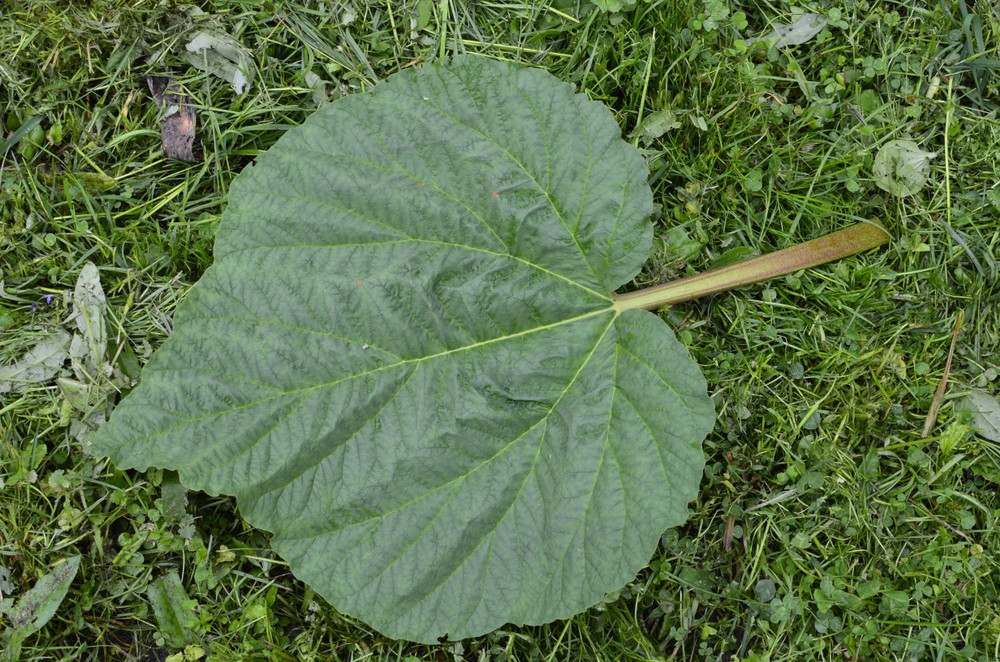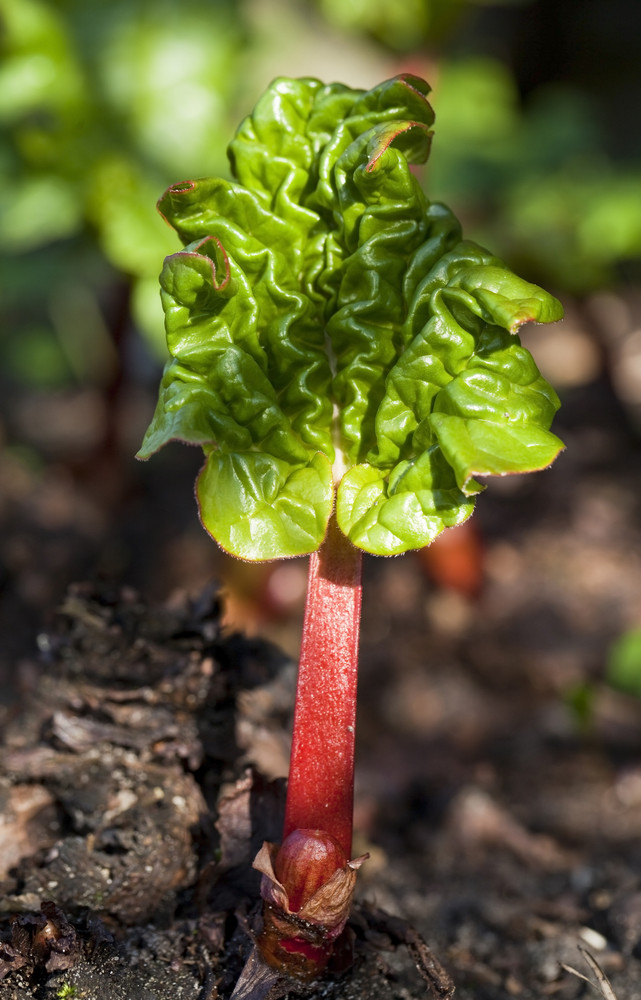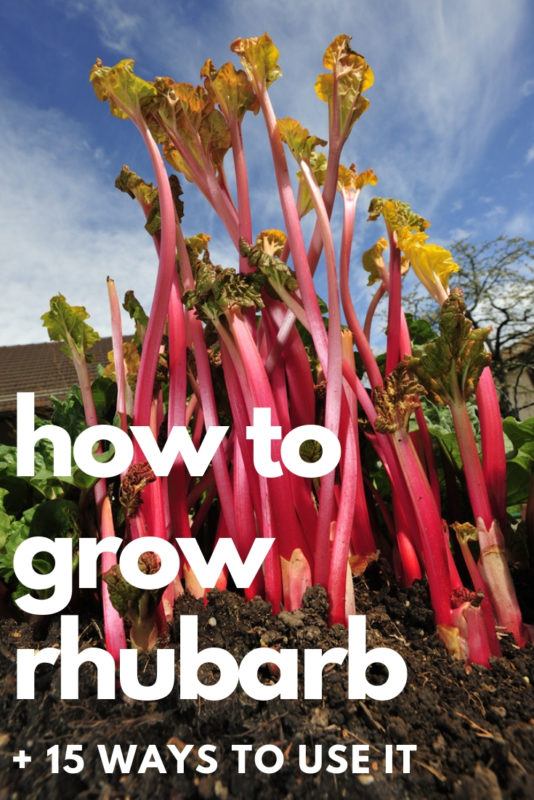
Known for its sour crimson stalks, rhubarb (Rheum × hybridum) is a perennial plant with a long history of use.
Though its origins as a culinary cultivar are unknown, rhubarb is thought to be derived from Rheum rhabarbarum, a leafy version without stalks that was cultivated for its medicinal roots as far back as 2700 BC.
It wasn’t until sugar became widely available in the 19th century that rhubarb really caught on as a food.
Pairing its natural tartness with the sweetness of sugar made it a wonderful filling for pies and tarts, and why it is also sometimes called the “pie plant”.
Although botanically speaking it is a vegetable, rhubarb is often used as a fruit in baking and cooking.
About The Rhubarb Plant…
Rhubarb is cultivated for its succulent stalks that are often red in color, but may be pink or light green.
When left undisturbed, it can reach a height of five feet and a spread of six feet. Rhubarb plants grow in rosettes, making them a great candidate for cut and come again gardening, providing you with many harvests throughout the growing season.
Rhubarb is a perennial vegetable that is hardy in USDA zones 3 to 8. Rhubarb can easily survive for 10+ years and there are many anecdotal reports of rhubarb plants lasting for 50 years or more.
It grows best in areas where the ground freezes for part of the year, since it requires temperatures below 40°F to become dormant during winter. In summer, it prefers cooler conditions between 59 to 68°F.
Though it can be grown from seed, it is much easier to purchase rhubarb crown starter plants like this one on Amazon. Once established, rhubarb can be propagated by division.
Nutritionally, rhubarb is low in calories and high in fiber. It’s a good source of vitamins K, C, and E with moderate sums of calcium, manganese, and potassium.
The bright red color of the stalks are indicative of its anthocyanin content – in fact, the deeper the hue, the higher the amount of these incredibly potent antioxidants.
For the richest source of anthocyanins, choose ‘Seedling Piggot’, ‘Vinrabarber’, or ‘Marshall’s Early Red’ varieties.
A word of warning about rhubarb leaves

While the stalks are completely safe to consume, the large leaves that form on top of the stem should never be eaten.
Rhubarb leaves contain high concentrations of oxalic acid, a toxic substance that is harmful when ingested, inhaled, or absorbed through the skin.
When harvesting rhubarb, use extra caution when handling the leaves. You may dispose of them by adding them to your compost pile.
How To Grow Rhubarb:

Although new rhubarb plantings will take 2 to 3 years to become established enough for a first harvest, it is well worth the wait.
Rhubarb is also one of the very first appearances in spring, a welcome sight after the long winter doldrums.
Light Requirements –
Plant rhubarb seeds or crowns in a spot that receives six to eight hours of sunlight per day. If you reside where summers are quite warm, choose a site that provides shade in the afternoon.
Soil –
Rhubarb are heavy feeders so enrich your garden soil with amendments high in organic matter like compost. Rhubarb prefers a balanced pH of 6 to 7.
Transplanting –
Plant rhubarb as soon as the ground can be worked in spring. You may also plant them in late fall after they have become dormant. Space plants 4 feet apart and inch or two below the soil line.
Watering –
Rhubarb plants need plenty of moisture so water well and often throughout the season. Mulch around each plant with straw to help retain moisture.
Fertilizer –
Rhubarb doesn’t need to be fertilized during its first year of growth. In subsequent seasons, enrich soil with organic matter and apply a high nitrogen fertilizer, such as alfalfa, in early spring.
Companion Plants –
Rhubarb grows well alongside strawberries, asparagus, and horseradish. Companion planting can really help fulfill your gardens potential by pairing plants that benefit each other mutually.
Forcing Rhubarb –

For sweeter, more tender rhubarb stalks, rhubarb forcing is a technique that limits photosynthesis to encourage quick growth that results in paler petioles. To force rhubarb that has been established for at least three years, simply cover plants with a bucket or terra cotta pot, covering up any holes or light leaks. Rhubarb stalks should be ready to harvest in about eight weeks. Do not force the same rhubarb plant two years in a row; alternate forcing between plants and allow them to grow naturally the following year.
Harvest –

As your rhubarb plants grow, remove seed stalks as they appear. Do not harvest rhubarb for its first year so its roots become well established. Once stems are at least 12 inches in length, snip stalks at the base of the plant and discard the leaves. Leave at least two stalks on each plant to keep it productive.
Storage –
Rhubarb is super easy to preserve for later use. Cut stalks into 1 inch pieces and store in a container in the freezer, no blanching needed.
15 Uses For Rhubarb
Rhubarb is an incredibly versatile food that can be roasted, baked, stewed, or boiled. Though it is best known for its dessert qualities, rhubarb can also be incorporated into many savory dishes and drinks.
1. Rhubarb Jam

While strawberry rhubarb jam is the classic spread, rhubarb also pairs up quite nicely with raspberries, blueberries, black grapes, peaches, cherries, oranges, or pineapples.
See the recipes here.
2. Rhubarb & Strawberry Pie
Another traditional recipe, this double crust pie is made with a pound of fresh rhubarb and two pints of strawberries. Sweet and tart, top this pie with a scoop or two of vanilla ice cream.
Get the recipe here.
3. Rhubarb Fool
Fruit fool is a simple British dessert made with sweet and sour fruits folded into a custard or cream. While there are many, many methods of preparing fool, and just as many ingredient combinations, this rhubarb rendition adds some modern twists for a light and refreshing summertime treat.
Get the recipe here.
4. Rhubarb Ice Cream
This three ingredient ice cream calls for finely chopped rhubarb, whipping cream, and sweetened condensed milk – no ice cream maker required.
Get the recipe here.
5. Rhubarb Chutney
Made with red apples, fresh ginger, red onion, and your choice of cranberries or cherries, rhubarb chutney is an excellent accompaniment to poultry, pork, and other meats.
Get the recipe here.
6. Sweet Pickled Rhubarb
Tasty served with wine and cheese or eaten straight out of the jar!
Get the recipe here.
7. Rhubarb Barbecue Sauce
Baste your veggies and meats with this sweet and sour (and optionally spicy) barbecue sauce before slapping them on the grill.
Get the recipe here.
8. Rhubarb Chicken Stir Fry
A healthful, low calorie, and Paleo friendly stir fry, this quick meal is prepared with chicken breast, fresh ginger, sliced strawberries, orange juice, lime, mint, and toasted almonds on a bed of spiralized zucchini veggie noodles.
Get the recipe here.
9. Rhubarb Tomato Soup
A complex and aromatic recipe that is ready to serve in half an hour, this creamy soup is topped with fresh lovage and a chopped bacon omelet.
Get the recipe here.
10. Rhubarb Salad Dressing
Add some tang to your spinach salad with this rhubarb vinaigrette dressing.
Get the recipe here.
11. Asparagus With Rhubarb Hollandaise
For this side dish, asparagus is lightly blanched and smothered in a creamy blend of sweetened rhubarb and fresh tarragon sprigs.
Get the recipe here.
12. Lentil & Rhubarb Stew
Served over basmati rice, this vegetarian stew blends the bold flavors of Indian spices with the tanginess of rhubarb and the mild heat of ancho chilis.
Get the recipe here.
13. Rhubarb Juice

All you need to make this juice is rhubarb and water for a lemonade-esque bevvie with no added sugar.
Get the recipe here.
14. Lemongrass Ginger Rhubarb Soda
Homemade soda is so much healthier than store bought pops – and this one is especially rich in vitamins and antioxidants thanks to the fresh ginger and lemongrass.
Get the recipe here.
15. Rhubarb Cocktails
From mojitos and mimosas to sours and fizzes, there appears to be no shortage of ways to incorporate your rhubarb haul into a sprightly cocktail.
See the recipes here.
Pin This To Save For Later

